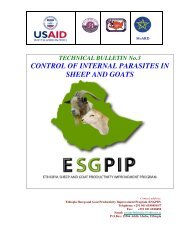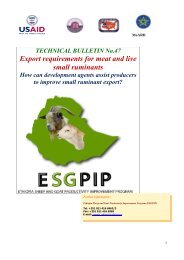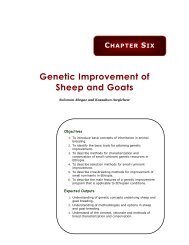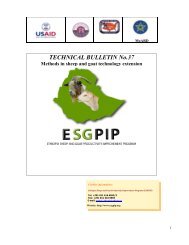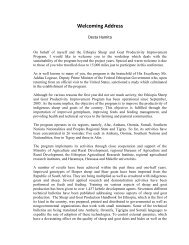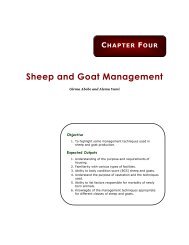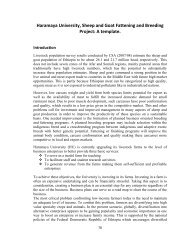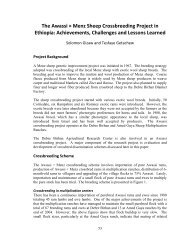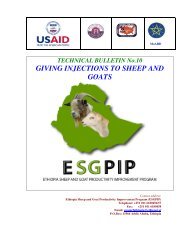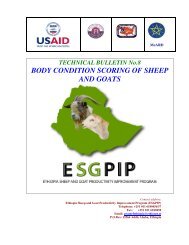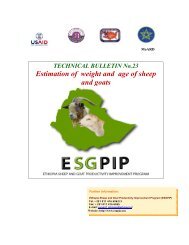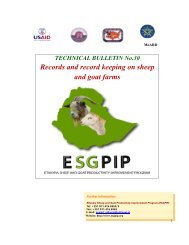Technical bulletin N.. - esgpip
Technical bulletin N.. - esgpip
Technical bulletin N.. - esgpip
- No tags were found...
You also want an ePaper? Increase the reach of your titles
YUMPU automatically turns print PDFs into web optimized ePapers that Google loves.
MoARDTECHNICAL BULLETIN No.14GENETIC IMPROVEMENT OF SHEEP AND GOATS ATVILLAGE LEVELFurther information:Ethiopia Sheep and Goat Productivity Improvement Program (ESGPIP)Tel. +251 011 416 6962/3Fax: +251 011 416 6965E-mail: pvamrf_ethiopia@ethionet.et
TABLE OF CONTENTSFOREWORDTABLE OF CONTENTSIII1. INTRODUCTION 32. PRINCIPLES OF BREED IMPROVEMENT 32.1. Variation in quantitative traits 32.2. Tools useful for breed improvement 42.2.2. Record keeping: 52.3. Methods of genetic improvement 52.3.1. Selection 52.3.1.1. Concepts of Selection 52.3.1.2. Methods of selection 72.3.1.3. Selection criteria 72.3.2. Mating system 72.3.2.1. Pure breeding 72.3.2.2. Crossbreeding 83. GENETIC IMPROVEMENT PROGRAMS 93.1. Nucleus breeding schemes 103.2. Practical methods of breed improvement 113.2.1. Individual flocks 113.2.2. Group flocks 123.2.2.1. Selection in group breeding schemes 12REFERENCES 14ANNEX. DEFINITION OF TECHNICAL TERMS 15ii
GENETIC IMPROVEMENT OF SHEEP AND GOATS AT VILLAGELEVELPrepared By:Kassahun Awgichew and Alemu YamiEdited by:R.C. Merkel and T. Gipson1. IntroductionThe aim of sheep and goat farmers is to improve productivity for increased income &food availability. Productivity can be improved by two approaches:• Improving the management of sheep and goats, so that their genetic potential canbe expressed as fully as possible. Improving feeding, disease and parasites controlor any other technical options.• Improving the genetic potential by selecting the best animals for future mating, orby introducing new genotypes.o Professional animal breeders may be needed to design detailed breedingplanso And there are many simple improvements that extension staff can suggest,with or without the advice of animal breeders2. Principles of breed improvementCharacteristics that can be passed on to the next generation due to genetic factors such asfast growth rate, high milk yield, etc constitute the genotype (G). Other characteristicssuch as adaptability to a particular environment cannot be passed on and are due to theenvironmental effect (E). The two components (genotype and environment) together areknown as the phenotype expression (P). This can be expressed in the form of an equationas follows:P = G + EIt is necessary to determine the proportion of the total variation in a population that is ofgenetic origin. Generally, the effects of G and E are expressed as deviations from theflock average. P = Flock average + Genotypic deviation + Environmental deviation.The genotype of an individual is determined by the genes, acting individually or incombination, passed on to it by its parents. Positive change or breed improvement occurthrough selection of superior individuals for mating. Selection and mating are the basictools of breed improvement2.1. Variation in quantitative traitsSuppose the 12- month live weight of a population of individuals of a given breed rangesfrom 17 to 47 kg. Figure 1 shows the possible frequency of each live weight. The scale isgiven in terms of Standard Deviation (SD-σ) and in kg. The mean live weight for thispopulation is 32 kg and the standard deviation (SD) as a measure of variation is 5 kg.3
Variation is the raw material of breed improvement. The variation seen in Figure 1 (17 to47 kg) shows that there is an opportunity to improve the 12-month live weight throughselection of animals to be used as breeding stock.. This gives an opportunity to improveperformance to the higher side of the weight range. The main tool used to make changesto this variation is selection. The objective is to improve the mean performance of a trait(traits) and reduce the degree of variation.-2 -1 0 +1 +2 σ| | | | | | |17 22 27 32 37 42 47 kgFigure 1. Frequency of live weight in a flock2.2. Tools useful for breed improvementAnimal identification, record keeping, estimated genetic value and breeding value, whichexpress the genetic worth of the animal, are important tools in any breed improvementeffort. Breeding value is defined as the value of an individual as a parent. Parents transfera random ample of their genes to their offspring. Estimated breeding value gives anestimate of the transmitting ability of the parent. The Breeding Value (BV) of an animalcould be estimated as follows:BV = heritability (h 2 ) of a particular trait X (individual average –average of contemporaries)orBV = h 2 X (individual deviation)2.2.1. Identification:Animals must be identified to differentiate performance and potential of individuals andmake decisions to use them for genetic improvement. There are many forms ofidentification such as using names or phenotypic appearance (in the case of small flocksize), ear tags (plastic or metal), ear notching, branding, and other means.4
a. Ear notching b. tattooing c. Ear tagFigure 4.13. Ear notching and pliers.2.2.2. Record keeping:Keeping simple records on individuals in the flock is a necessary activity to baseselection judgments on actual information. Recorded information on reproduction,maternal ability, growth, carcass and lactation is necessary in making breeding andculling decisions. Accurate records are needed to identify the best and poorest performinganimals on a farm. Performance recording is also an aid for making managementdecisions like provision of individual care.2.3. Methods of genetic improvementThe methods used for genetic improvement are:1. Selection within (or between) local breeds on which animals to keep as parents.2. Crossbreeding with improved breeds.2.3.1. Selection2.3.1.1. Concepts of SelectionSELECTION IS CHOOSING! It is the business of making decisions about a particularanimal based on the information available on that particular individual animal and itscontemporaries. Selection can be natural or artificial. It is the process in which the bestanimals are chosen to be parents of the next generation. Unselected individuals areremoved from the population through castration or removal from the flock by selling themales. This process continues from generation to generation. The main effort in selectionshould be directed towards males. This is because it is the male that can produce moreoffspring. Its impact on genetic improvement per generation is, thus, higher.In order to reduce inbreeding, a ram/buck should never be allowed to mate with his fullsisters, his daughters, his granddaughters or his dam. Additionally, the number of years amale serves should be limited to one. The male should then be replaced either throughexchange with other flock owners or through purchase of a new sire.Farmers within a certain area may reach agreements to exchange the best rams/bucksfrom their flocks with other farmers engaged in the exchange on a rotational basis. Ifexchange is not done, males at the end of their service can be sold immediately or can be5
Nucleus of improvedbreedSelected malesof exotic breedNucleus HerdPurebreeding indigenous breed----------------------------------Crossbreeding to produce malesSelected for highperformanceCrossbred males for distribution tovillage herdsVillage herds (pure breed)-screening for "best"indigenous females to enternucleus herdPurebred indigenousmales for limited use invillage herds"upgrading" of local population(all excess animals could be marketed)Figure 4. Open Nucleus breeding scheme for conservation and improvement3.2. Practical methods of breed improvementBreed improvement in sheep/goat populations can take place at the level of individualflocks, village flocks and/or district/national level.3.2.1. Individual flocksPossibilities of genetic improvement depend on the size of the flock owned. In flockslarger than 100 sheep/goats, an owner would be able to make genetic improvementsthrough selection within his own flock. In the case of small flocks, there is little scope forselection due to inadequate variability. Up-grading through crossbreeding is an option inthis case. Clear guidelines for breeding and culling should be in place to ensure thatinbreeding does not increase. The following steps and procedures should be followed inan individual flock selection program:• Put down a clear objective/goal of the selection program• Implement animal identification and record keeping• Measure the traits• Select sheep/goats for mating based on concrete information relating to theobjective/goal. Farmers have their own criteria and due consideration should be givento these• Cull low performing animals• Measure progress• The best rams/bucks in the flock should be selected and retained for 1 to 3 years• A ram/buck should never be allowed to mate with his dam, full sisters, his daughtersor his grand-daughters11
If new rams/bucks can not be bought i.e. in case of a "closed flock" the following can bedone:• One ram/buck should be selected each year to be the breeding ram/buck for the year• After serving one year, the ram/buck should be culled, or a breeding control deviceapplied. Exchange or rotate breeding males every 1 or 2 years regularly among asmall groupA superior ram/buck can be used for more than 1 year if the owner separates the flockinto groups.3.2.2. Group flocksUnder circumstances where flock sizes are small there will be a need to form an ownersgroup to exert selection pressure on their larger, combined flock. This also provides thepossibility to make use of a superior ram/buck by sharing the cost of an improved maleamong many members. Government and NGOs can play an important role in assistingsheep/goat keepers to organize breed improvement, or developing improved stock onbreeding stations.3.2.2.1. Selection in group breeding schemesIn group or cooperative breeding schemes, members agree to set up a nucleus flock oftheir best goats/sheep to produce their replacement breeding males.Steps:1. Members meet and agree on the objectives of the breeding scheme, its structureand organization.2. Terms of membership of the scheme are clearly set out3. Group members contribute the foundation stock for the nucleus flock4. Rigorous selection procedures are applied to this central flockFigure 5. Outline structure for a possible sheep selection program12
Guiding principles• Start small, e.g., with a community grazing sheep together, members of which knoweach other well.• Catalyze the formation of a ‘self-help’ type cooperative and ensure the advantages offorming a coop.• Ensure the running of the activities of the cooperative, including decision-making andactual work is in the hands of members.• A revolving fund which is eventually paid back and used elsewhere to start a similarscheme is the best way to achieve and to build self confidence. The source of the fundmay be contributions by members and/or contributions from the government/NGOs.Structure and operations:• Use the breeding scheme as the organizing unit around which to build overallimprovement; the scheme should NOT just be about breeding.• The management package has to include husbandry, including health and nutrition –this has to be built into the scheme, including capacity building to empower farmersto do much of these on their own.• Culling has to be associated with value-adding activities – e.g., fattening andinnovative marketing to ensure that the culled animals fetch competitive prices(through forming farmers' coops, linking them up with markets, etc) and form a basisfor capital formation for participating farmers.• Farmers should make the selection/culling decisions possibly through a panel they areassisted in forming.• Key activities such as weighing should, over time (but as soon as possible) be doneby farmers themselves.• Initial training will be required, but the idea is to make farmers OWN the processesand the eventual outcome – including success!• Include serious considerations of input supplies and output markets; for example,facilitating contracts to supply products to whole-sellers, abattoirs, etc.• The scheme could be used for pure-breeding (selection within breeds), for deliveringcrossbreds to farmers, or to facilitate formation of a synthetic breed.• There have to be products going to market at any stage (i.e. throughout the year). It isthe additional income that is the driving force for sustained implementation of geneticimprovement measures.13
What can the Kebele Development Agent do?Animal identification:• train your farmers on the importance of animal identification for breed improvement andmanagement and convince them to take steps.• Demonstrate use of appropriate methods. Discuss alternative means of identification and agreeupon an applicable method.• Record keeping:• Develop a simple record and train a member of the farming household on how to keeprecords;• At intervals, inspect the records that are kept and take corrective measures if you identifyproblems in record keeping;• Demonstrate the usefulness of the records by showing the use of the information in the recordsfor improvement.Selection:• train farmers on the value of selection and culling in breed improvement; Selection tools andmethods. Refer to technical <strong>bulletin</strong> No. 4 "Selecting breeding stock for sheep production" forthe purpose.• Discuss with farmers the selection criteria they use and additional criteria enumerated in this<strong>bulletin</strong> they should use.• Progress can be achieved by advising farmers not to sell (with the intention of getting moremoney from the sale) their best animals and not to sell indiscriminately. Rather, farmersshould keep superior males for breeding and superior females for replacement.• train farmers on the removal of males undesirable for breeding by castration and other means.Promoting genetic improvement:• Individual flocks:o Train farmers who have flock sizes of more than 100 to take steps outlined in section 3.3.1of this <strong>bulletin</strong>.• Group flocks:o Train farmers who have small flock sizes and using the same communal grazing area willhave to be organized in groups. The KDA can take the lead to convince farmers of breedimprovement and concrete steps of organizing the farmers and other steps as outlined insection 3.2.2 of this <strong>bulletin</strong>.4. SUMMARYThe general principles of genetic improvement of sheep and goats are outlined. Theapplications of these principles at village level in Ethiopian farms and villageflocks using common grazing areas is also shown. The role of kebeledevelopment agents in training farmers and organize them to work towards acommon goal of genetically improving their flocks is highlighted.14
5. ReferencesAlabama Meat Goat and Sheep Producers: Small Ruminant Pocket Guide, Alabama A &M and Auburn Universities, 6M, New July 2006, ANR-1296.Dalton, D.C. 1980. An Introduction to Practical Animal Breeding. Granada Publishing.ESGPIP. 2008. Sheep and Goat production Handbook for Ethiopia. Alemu Yami andR.C. Merkel (eds.). 350pp.Horst, P. and P.K. Mathur. 1991. Breeding objectives and strategies. In: Panandam, J.M.,Sivaraj, S; Mukherjee, T.K. and Horst, P. (eds). Goat Husbandry and Breeding inthe Tropics. Compiled papers presented in an international seminar carried out byGerman Foundation international for Development (DSE) at the Institute forAdvanced Studies, university of Malaya, Kuala Lumpur.)Ibrahim, H. 1998. Small Ruminant production techniques. ILRI training manual 3. ILRI(International Livestock Research Institute), Nairobi, Kenya. 207pp.Kiwuwa, G.H. 1992. Breeding strategies for small ruminants in Africa in B. Rey S.H.B.Lebbie L. Reynolds (eds.). Proceedings of the First Biennial Conference of theAfrican Small Ruminant Research Network. ILRAD, 10-14 December 1990,Nairobi, Kenya.Philipsson, J., Rege, J.E.O. and Okeyo, A.M. 2006. Sustainable breeding programs fortropical farming systems. In: Animal Genetics Training Resource, version 2,2006. Ojango, J.M., Malmfors, B. and Okeyo, A.M. (Eds). InternationalLivestock Research Institute, Nairobi, Kenya, and Swedish University ofAgricultural Sciences Uppsala, Sweden.Turner, H.N. 1982. Basic considerations of breeding plans. In:Gatenby, R.M., and TrailJ.C.M. (eds) Small Ruminant Breed Productivity in Africa. Proceedings of aseminar held at ILCA, Addis Ababa, Ethiopia. ILCA, Addis Ababa.6. Annex. Definition of technical termsBreed: Is either a sub-specific group of domestic livestock with definable andidentifiable external characteristics that enable it to be separated by visualappraisal from other similarly defined groups within the same species, or a groupfor which geographical and/or cultural separation from phenotypically similargroups has led to acceptance of its separate identity.Breeding value: The value of genes to progeny15
Conservation: All human activities, including strategies, plans, policies and actionsundertaken to ensure that the diversity of farm animal genetic resources is beingmaintained to contribute to food and agriculture production and productivity, nowand in the future.Crossbreeding: A mating scheme utilizing two or more breeds.Full-sibs: Animals having the same dam and sire.Gene: Basic unit of heredity that is located on chromosomes and affects a specific trait.Generation interval:replacement.Average time between birth of an animal and birth of itsGenetic value: The value of genes to self; it includes non-additive effects (such asdominance) which cannot be passed on to progeny.Genotype: The genetic make-up of an animal.Grading-up: Repeated mating of females and their female offspring with sires of aparticular breed to produce a crossbred animal indistinguishable from the desiredsire breed.Half-sibs: Animals having one parent in common.Heritability: The amount of variation in a trait which is due to genetic differences.Heterosis: The increase in performance associated with the crossbred animal whencompared to the average of the purebred parents.Heterozygous: A gene pair with different genes for the same trait.Homozygous: A gene pair where both genes are identical.Inbreeding: Mating of individual animals that have common ancestry and are closelyrelated, e.g., dam and son, siblings, etc.Inbreeding depression: Reduction in performance due to inbreeding.Nucleus flock: A flock or herd of the best animals available for the purpose ofdeveloping superior stock. A breeding scheme used by a group of producers topool their best animals into one flock for the purpose of developing superioranimals.Open nucleus: Nucleus flock that continually allows introduction of superior animalsfrom cooperator flocks.16
Phenotype: The expression of genetic traits.Selection: Any natural or artificial process that permits an increase in the proportion ofcertain genotypes or groups of genotypes in succeeding generations in relation toothers.17



